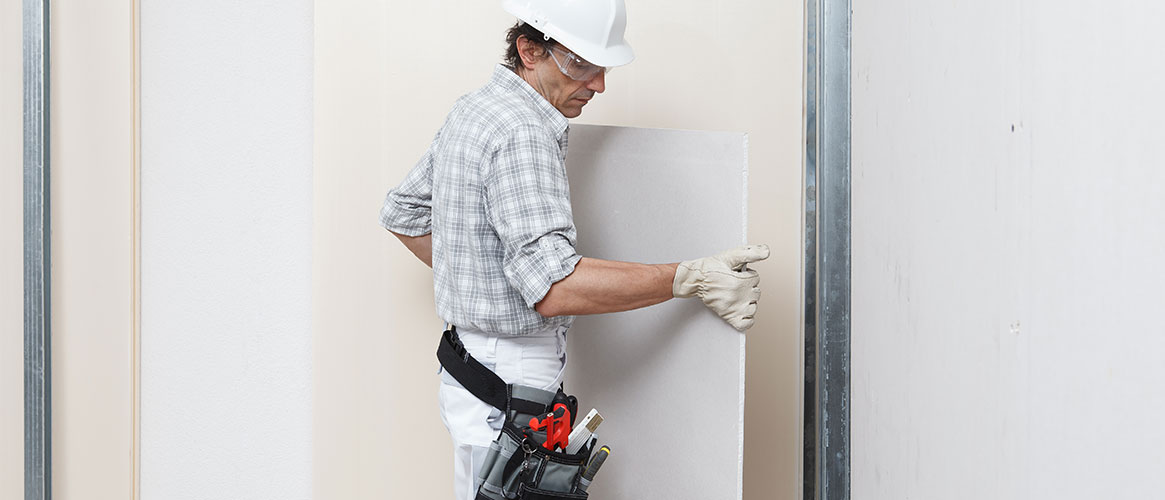Drywall installers help finish the inside of homes and offices by putting up walls, but their jobs can be dangerous. One of the biggest risks is falling from high places. Workers can suffer back injuries when lifting and carrying heavy drywall sheets. Another danger is breathing in dusts, such as silica, that can harm the lungs. It is important to know about these risks to help your workers stay safe and healthy on the job.
Preventing falls
Drywallers often work at heights to install tall walls and ceilings. A fall of just three-to-four feet could result in broken bones and other injuries serious enough to require medical treatment.
When using a ladder, always remember to select the proper ladder for the job, inspect it for damage prior to use, and keep three points of contact when climbing up or down. In addition, never step on the top step or top cap of a step ladder.
With scaffolds, drywallers can use either stationary ones or mobile rolling scaffolds. Stationary frames must be constructed by a qualified person. They should be inspected prior to each use by a competent person to ensure that it is in a safe condition. All scaffolds should have level, stable working platforms, be fully planked, and have the necessary safety railings to prevent workers from falling.
The proper footwear, such as shoes with non-slip soles, can reduce the risk of fall injuries. Drywall project floors can be wet and slippery. Materials such as drywall mud are frequently on the floor, ladder rungs, scaffolds, and other surfaces. As much as possible, there should be good housekeeping practices and employees should frequently check the soles of their shoes for mud build up which can be the reason for a slip and fall. It’s essential that drywallers maintain their footing when climbing ladders or working on scaffolds.
And, on the ground level, keep floors and pathways clear to avoid trip hazards.
Avoiding sprains and strains
Drywall sheets typically range from 39-to-110 pounds each. Handle these sheets carefully during transport and installation to prevent strains and sprains to the back, shoulders, and arms. First, have the sheets delivered and stacked as close to the installation site as possible. Next, use forklifts, dollies, and drywall lifts and/or jacks to move and position sheets.
Minimize hand carrying and installation. Pick up one sheet at a time. Special sheet gripper tools or grip-dot gloves help you hold sheets securely without exerting a lot of handgrip force. Working in teams of two makes it easier to lift and maneuver heavy sheets of drywall into place. Lift sheets with the legs and a straight back and avoid twisting the back while lifting.
Minimizing exposure to dangerous substances
Drywall sheets and joint compound contain hazardous ingredients. This includes talc, calcite, mica, gypsum, and silica. Drywall dust contains crystalline silica, mica, and talc—all of which OSHA identifies as hazardous materials.
Read the safety data sheets (SDS) for your brand of drywall and compound for manufacturer-recommended safe work practices.
- Minimize dust emissions and use good ventilation.
- Use wet methods for sanding and vacuum-equipped cutting and sanding tools.
- Use a pole-sander to keep the dust away from your face.
- Wear safety glasses and a respirator when exposed to dust.
- Carefully mix dry compound powders to avoid creating a dust cloud.
- Don’t use dry cleanup methods such as air compression hoses or brooms.
Costly injuries can be prevented by taking the necessary safety measures. This includes providing regular safety training on the proper selection, inspection, and usage of ladders and scaffolds. Working in teams of two when handling drywall, and wearing non-slip shoes. It is the responsibility of every worker to ensure that proper planning and effective safety procedures are in place to help prevent the different types of injuries that can occur when installing drywall.
